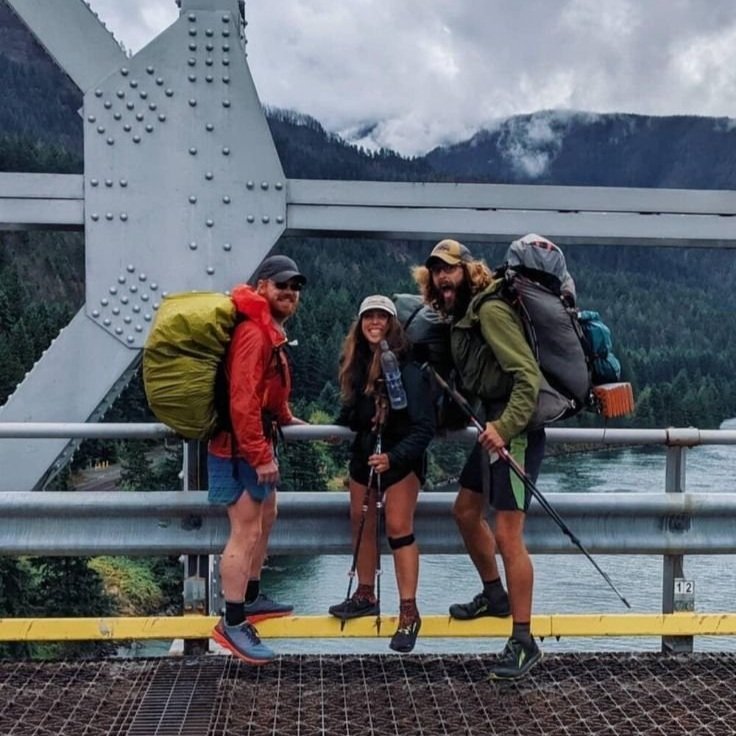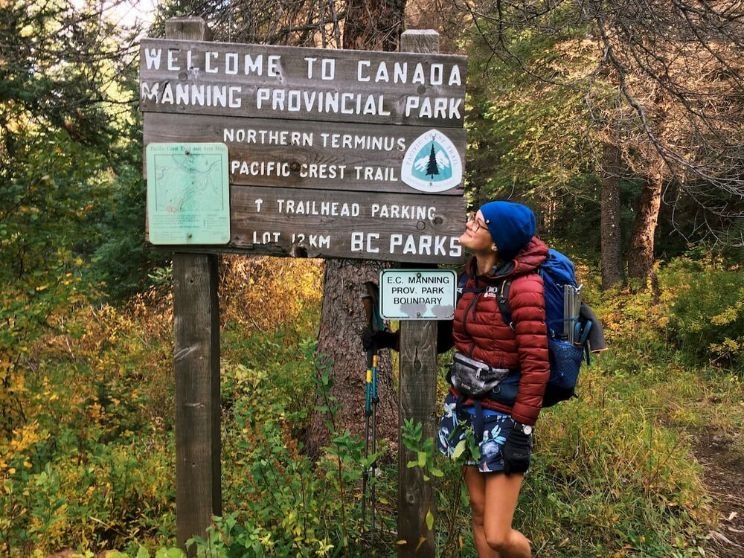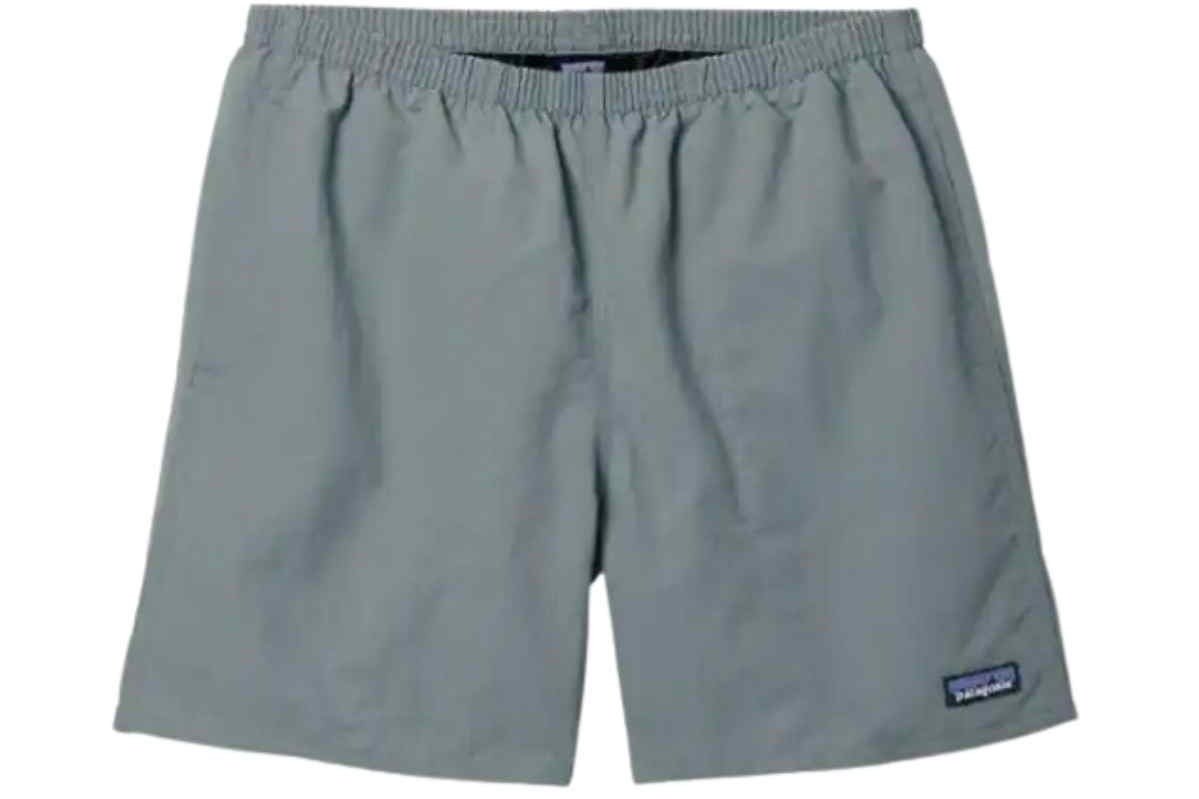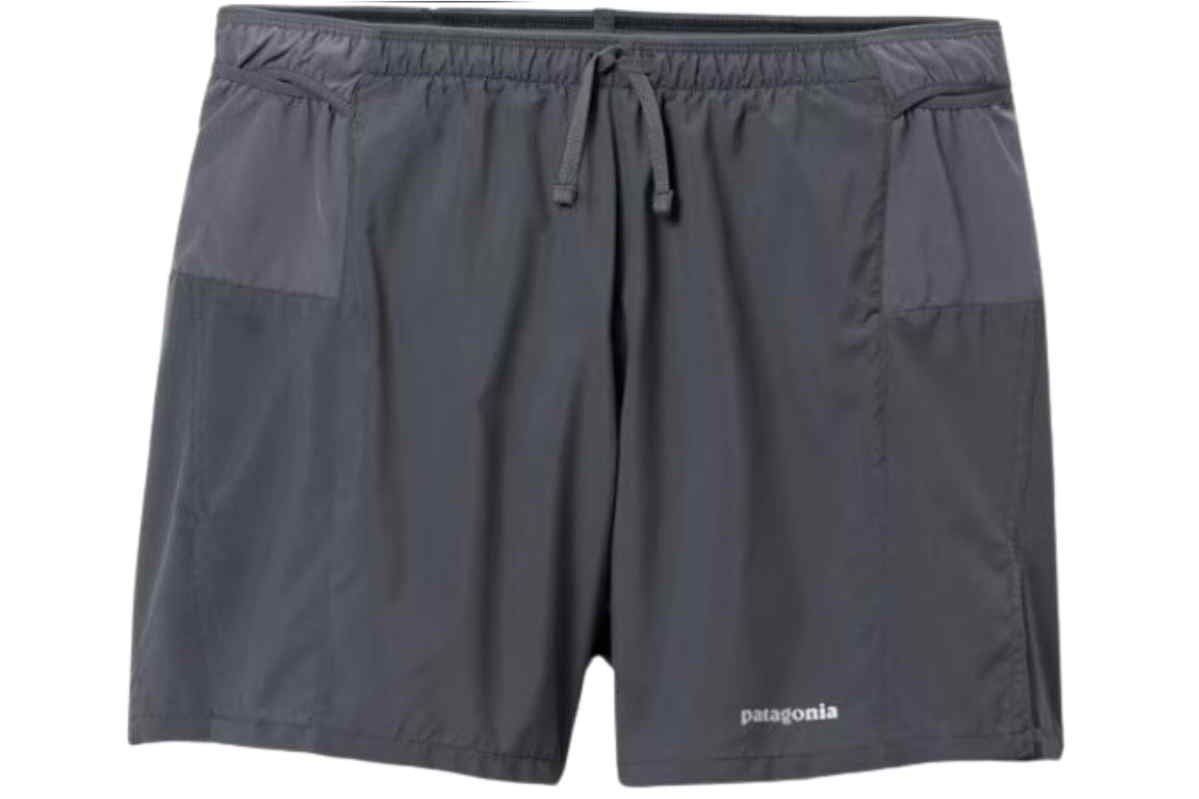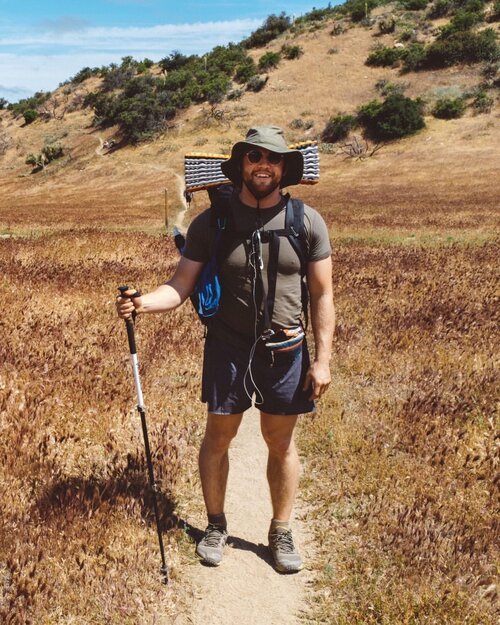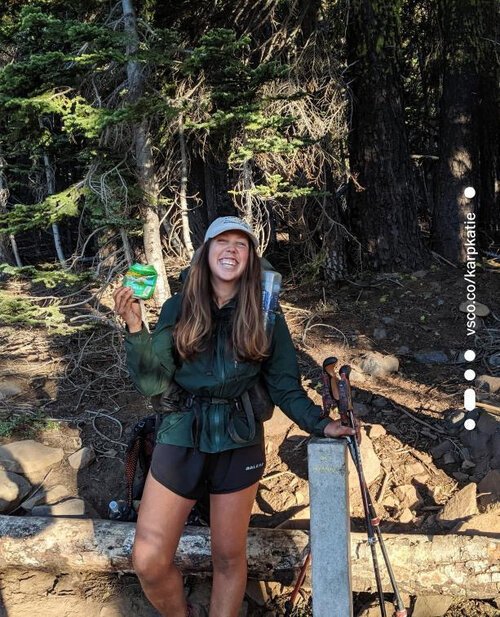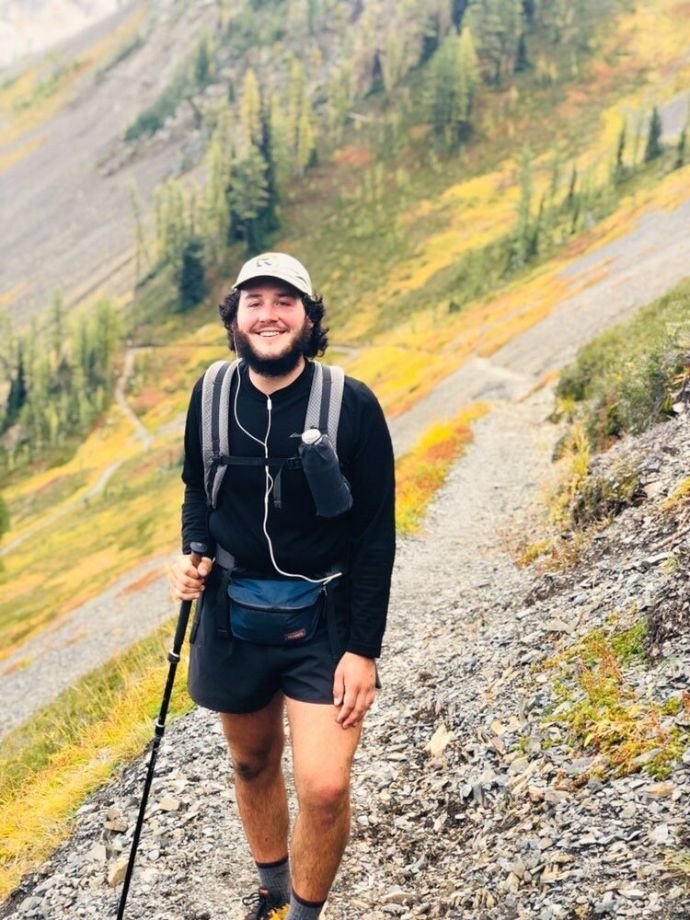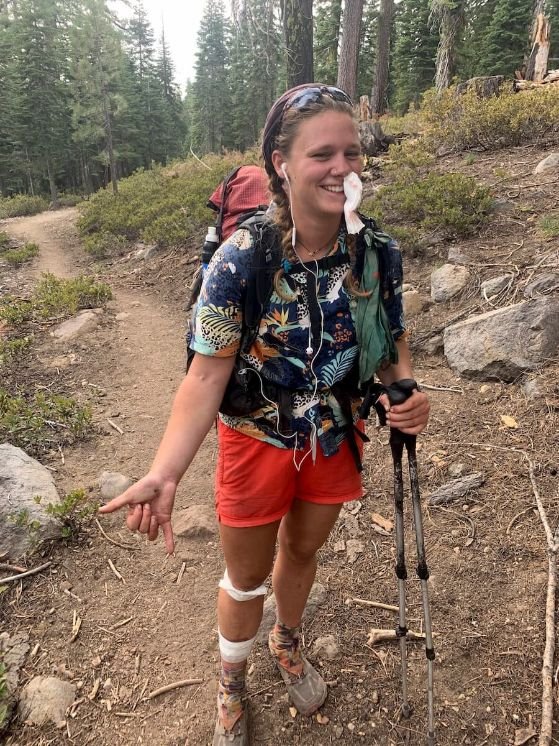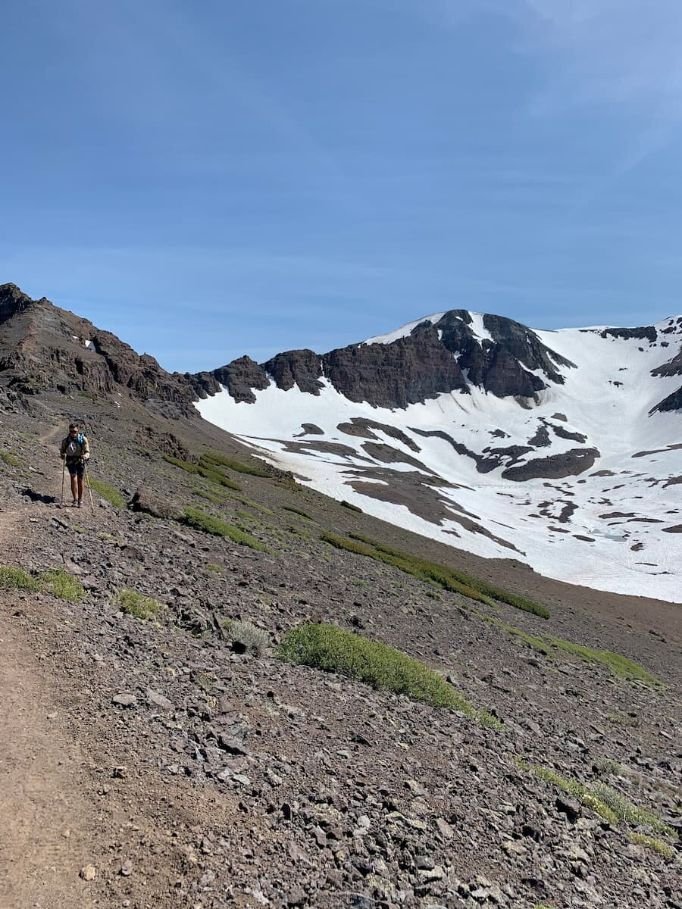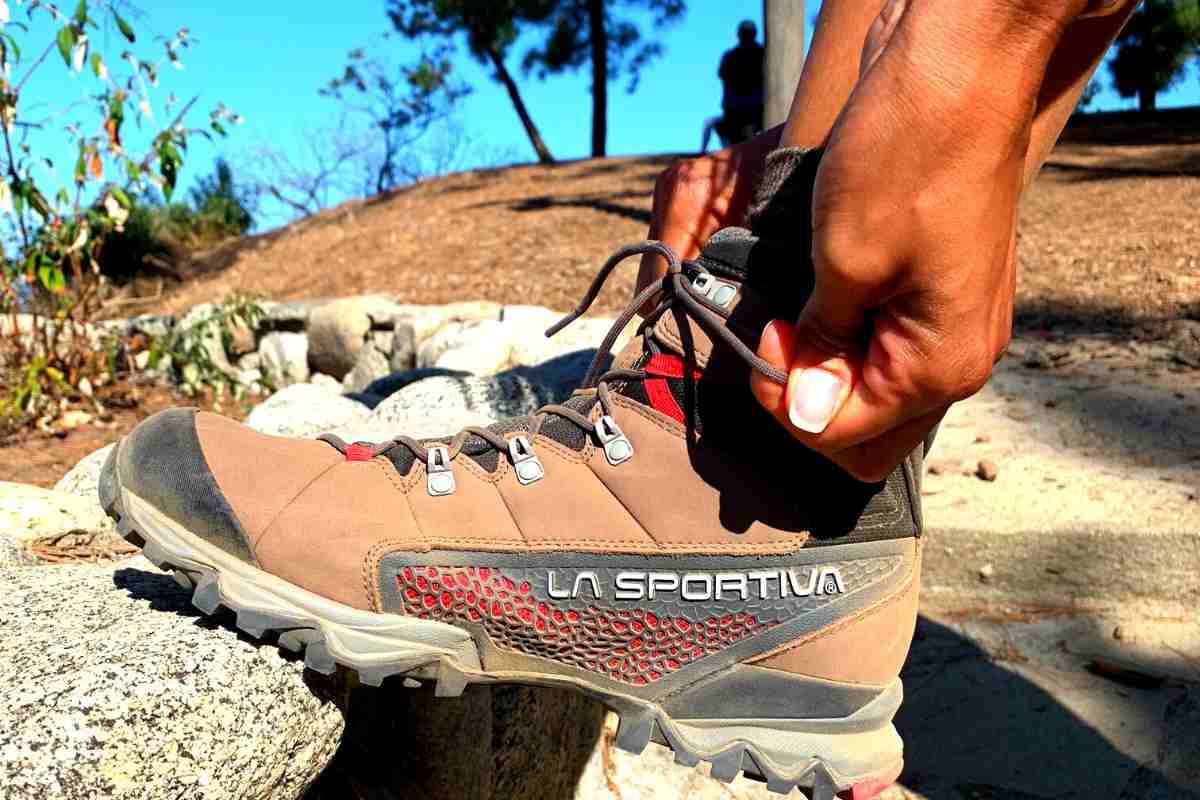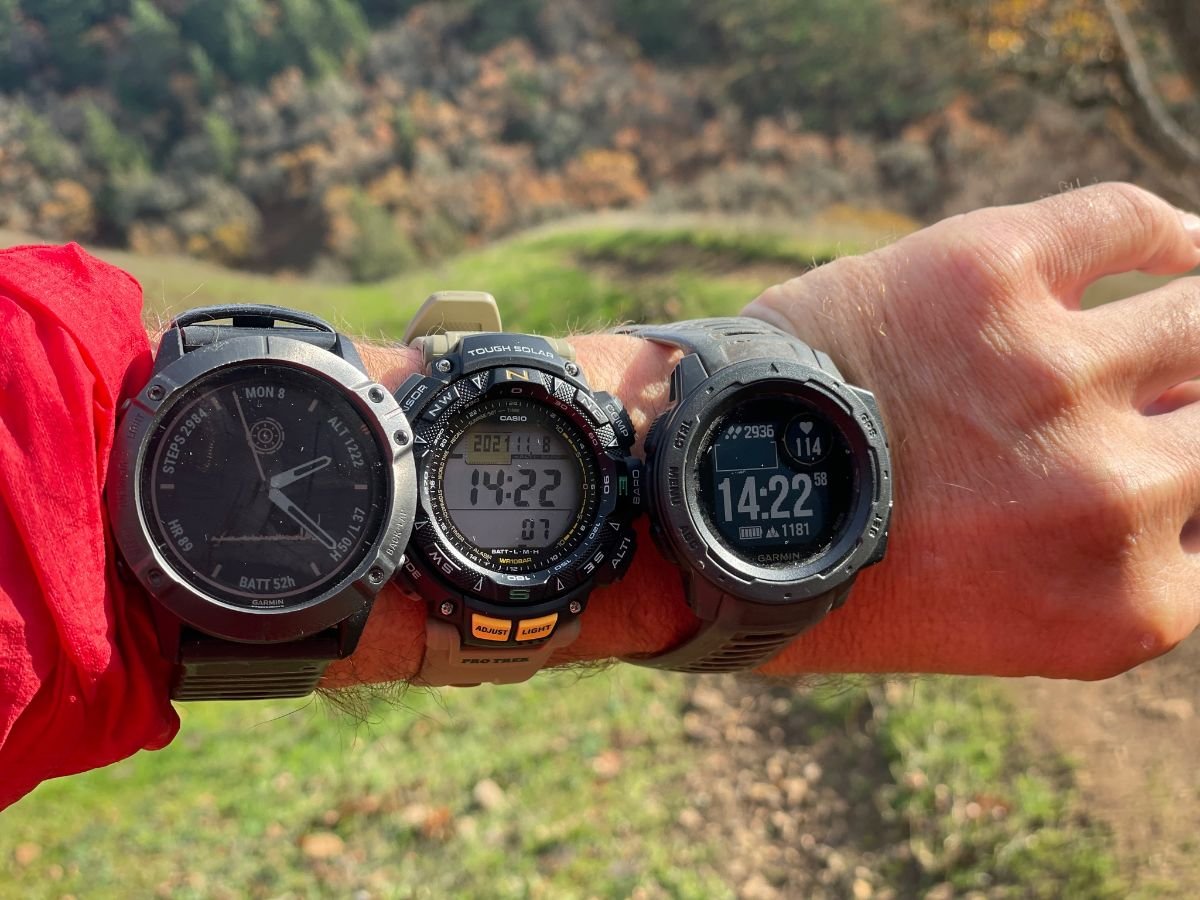Best Shorts for Thru Hiking 2024
Backpacking and Thru-Hiking Shorts for All Shapes and Sizes
Thru-hikers on the Bridge to Nowhere in Cascade Locks, OR. Photo courtesy Katie “SOBO” Karp @katiekarp
Home > Gear Reviews > Apparel
May 10th, 2024
Even with thru-hiking becoming more popular, it’s still hard to find quality advice on hiking clothes while preparing for your own trek. In this article, we interviewed dozens of thru-hikers to find the best shorts to wear while thru hiking.
No matter what length or style, we found shorts that met our criteria of durable, lightweight, and breathable. We considered dozens of models and tested them over thousands of miles of hiking to find the best pair of shorts for thru-hikers of all sizes and shapes.
Thru-hiking on your mind?
We create reader-supported, objective gear reviews independently selected by our editors. This story may contain affiliate links, which help fund our website. When you click on the links to purchase gear, we may get a commission, without costing you an extra cent. Thank you for supporting our work and mission of outdoor coverage for every body! Learn more.
For more of our favorite thru-hiking gear recommendations, see our most popular Gear Guide stories:
Men's comparison table
| MEN'S SHORTS | TREELINE AWARD | WEIGHT | INSEAM LENGTH | LINER | MATERIAL | STRECHINESS (1-10) |
|---|---|---|---|---|---|---|
| Patagonia Baggies | Best Overall Read why |
4.2 - 8.0 oz | 5" or 7" | Yes | 100% recycled nylon | 4 |
| Patagonia Strider Pro | Best Upgrade Read why |
2.8 - 3.9 oz | 5" or 7" | Yes | 100% recycled polyester stretch ripstop | 7 |
| Lululemon Pace Breaker | Best Stretchy Read why |
N/A | 7" or 9" | Both available | 86% polyester, 14% elastane | 8 |
| BALEAF Running Athletic Shorts | Best Affordable Read why |
5.6 oz | 5" or 7" | Yes | 95% Polyester, 5% Spandex | 8 |
| BOA Half Split Trainer | Best Ultralight Read why |
N/A | 3" | Yes | 100% polymicro polyester | 7 |
Women's comparison table
| WOMEN'S SHORTS | TREELINE AWARD | WEIGHT | INSEAM LENGTH | LINER | MATERIAL | STRECHINESS (1-10) |
|---|---|---|---|---|---|---|
| Patagonia Baggies | Best Overall Read why |
4.2 - 8.0 oz | 2.5" or 5" | No | 100% recycled nylon | 4 |
| Patagonia Strider Pro | Best Upgrade Read why |
2.8 - 3.9 oz | 3" | No | 100% recycled polyester stretch ripstop | 7 |
| Lululemon Hotty Hot | Best Stretchy Read why |
N/A | 2.5" or 4" | No | 86% polyester, 14% elastane | 8 |
| BALEAF Running Athletic Shorts | Best Affordable Read why |
5.6 oz | 3" | Yes | 95% Polyester, 5% Spandex | 8 |
| BOA Half Split Trainer | Best Ultralight Read why |
N/A | 1.5" | Yes | 100% polymicro polyester | 7 |
| Prana Halle | Best Traditional Hiking Shorts Read why |
5.1 - 10.1 oz | 5" or 7" | No | 97% nylon, 3% elastane | 6 |
| REI Active Pursuit | Best Trusted Budget Read why |
6.3 oz | 4.5" | Yes | 86% polyester, 14% spandex | 8 |
THE BEST SHORTS FOR THRU HIKING
Snacks in Patagonia Baggies at the Canadian border. Photo courtesy Emily Golitzen @sewer__brat
Best Overall Thru-Hiking Shorts: Patagonia Baggies
Material: 100% recycled nylon
Liner: Mesh
Pockets: 2 and 1 rear snap pocket
Enclosure: Elasticized waistband with an internal drawstring
Weight: 7.8 oz (men’s medium 7”)
Inseam: 2.25” (women’s Barely Baggies), 5”, 7”
Fit: Baggie
What we liked: comfort, fit, lots of size/color options, length options, recycled material, price, quality, durable enough to last a thru-hike, warranty, quick dry, elastic stays up, drawcord helps change waistband length as hiker bodies change, airflow
What we didn’t like: could be more size inclusive
The Patagonia Baggies are the thru-hiker favorite and one of the most common thru-hiking shorts on long trails. Marketed as the all-encompassing adventure short, the Patagonia Baggies are made out of 100% recycled nylon with a breathable black mesh liner (more on that below). Available in five- and seven-inch inseams and in fun colors and patterns, these shorts are diverse enough to fit most thru-hiking needs. At 7.8 oz (for men’s medium with a 7” inseam), they are light enough to not be noticeable while you’re hiking but sturdy enough to last a thru-hike.
View The Patagonia Baggies
Men's
Women's
“Snacks” at the Cascade Locks, OR monument on the PCT. Photo courtesy Emily Golitzen @sewer__brat
Pockets
Patagonia Baggies have two deep front pockets that feel like you could almost fit in a bottle of wine. Anyone who knows what big miles lie ahead in Oregon knows this can sometimes come in handy.
All jokes aside, the deep pockets are handy in trail towns (for carrying around wallets and phone when you don’t want to cart around your entire backpack). Those pockets are always good for carrying extra easy-to-access snacks on trail, too.
The Patagonia Baggies also have a rear snap pocket on the back that is an added space for stashing smaller things. The snap closure will ensure that nothing falls out while hiking.
Rebecca "Ruthless' Baumher wearing the Patagonia Baggies through a burnt section of the PCT. Photo courtesy Rebecca Baumher @hex.bex
Elastic
To hold them up, the Baggies have an extremely effective internal elastic and drawstring system. Unlike some of the shorts we tested, the drawstring is thick, reliable, and sewn-in all around (including the back) to perfection. While it’s common for thru-hikers to complain about their elastic and drawstrings with other brands of shorts, that’s one of many design features where the Patagonia Baggies excel.
Fit
It’s worth noting that the Baggies have, well, a baggy fit. This is a real benefit for airflow and minimizing sweaty legs while thru-hiking. It’s also good for people with bigger thighs.
Sustainability
Patagonia is known for its environmental mission, and the shorts are made from nylon fabric spun from recycled materials. But what makes Patagonia different is that to add to their eco-mission, the Baggies come with an Ironclad Warranty. Patagonia will repair your shorts for life so that you can keep loving the same pair instead of sending them to a landfill.
“Hot Take” wore the Baggies for the first 360 miles of the PCT. Photo courtesy Liam "Hot Take" Purtle @50shadesofpale
Thru-Hiker Testimonials
Liam “Hot Take” Purtle (wore for 2 years + 345 PCT Miles):
I owned the Baggies in blue with the 7-inch inseam for about two years before starting the PCT. I loved them. I wore them everywhere. While they were amazing for me prior to trail, they didn’t make it very far on my thru-hike. At mile 77 in Julian, California, I bent down in our hotel room to grab my water filter and they completely split down the middle of my butt. Now, this probably wouldn’t have happened if I didn’t own them for two years prior but they still split. I wore them split for the next 100 miles and then when we got to Idyllwild, a fellow hiker sewed them for me. The sewing didn’t last long and they were completely ruined by Wrightwood at around mile 360.
Besides them splitting on me, I really enjoyed them. I know many hikers who made it all the way to Canada in their Baggies. I actually just bought another pair of Baggies to give them another try! :) P.S- Also important to note, that they are BAGGIE – they are not as slim fitting as some of the other shorts I have worn hiking. (Editor’s note: the bagginess is great for airflow and staying cool while hiking, but not everyone may like the look).
Rebecca "Ruthless' Baumher wearing the Patagonia Baggies on her thru-hike of the PCT. Photo courtesy Rebecca Bauhmer @hex.bex
Emily “Snacks” Golitzen (wore for 2,650 miles – the entire length of the PCT):
I looooooved my Baggies. Pro-tip is that (for women’s styles anyway) the longer inseam has a different waistband than the shorter inseam! The elastic is sewn directly inside the waistband where the ones with shorter inseam have a fabric covering the elastic. People seem to prefer one or the other. I personally thought the longer ones were more comfy so that’s what I wore. Also since they were originally designed as board shorts, the nylon fabric dries super quickly and is comfy for swimming in! Excellent for trail dips. I also find that most Patagonia bottoms run a little big so I would size down if you’re between sizes.
(Editor’s note: The Patagonia Women’s Barely Baggies are available in the 2.25” inseam and have a different elastic than the Women’s Baggies in the 5” inseam).
The Strider Pros are lightweight and stretchy, feeling free for a variety of movements. Photo courtesy Andrew “Peanut” Glenn.
Best Upgrade Thru-Hiking Shorts: Patagonia Strider Pro
Material: 100% recycled polyester stretch ripstop with a DWR finish
Liner: Yes, 42% recycled polyester with Polygiene® permanent odor control
Pockets: 4 envelope pockets and one zip pocket on the center back
Weight: 3.9 ounces (7”)
Enclosure: external drawstring with elastic waistband
Inseams: 3” (women only) 5” and 7” (men only)
Fit: semi-baggy
What we liked: comfort, fit, recycled material, durable enough to last a thru-hike, warranty, quick dry, elastic stays up, airflow
What we didn’t like: could be more size inclusive
Many thru-hikers consider the men’s and women’s Patagonia Strider Pro to be “next level” Patagonia Baggies. They have many of the same features that we love in the Patagonia Baggies, but are lighter and have more pockets. The Strider Pros are half the weight of the Baggies at 3.7 ounces (for size medium) and have double the pockets – four envelope pockets for easy stashing and one zip pocket on the center back. Because of their lighter weight and abundance of pockets, the Patagonia Strider Pros are also the overall winner for Best Men's Trail Running Shorts and Best Women's Trail Running Shorts, making them one of few items on Treeline Review that has won multiple awards.
View The Patagonia Strider Pro
Men's
Women's
Andrew “Peanut” Glenn wore the Strider Pros on the CDT. Photo courtesy Andrew “Peanut” Glenn.
Stretch
Patagonia makes the Strider Pros specifically for trail running, so have 11% Spandex that gives them extra stretch during movement. Just like the Baggies, the Strider Pros come in a 5” and 7” inch inseam. The body of the shorts is made with 100% recycled polyester stretch ripstop with a DWR finish. The pockets are made with 89% recycled polyester with 11% spandex. The mesh liner is also made of 42% recycled polyester. Wondering whether to wear hiking underwear underneath? See below.
Peanut wore one pair of Patagonia Striders for the entire length the CDT and GDT. Photo courtesy Andrew “Peanut” Glenn.
Patagonia Baggies vs. Strider Pros
Besides the fabric and pockets, a significant difference between the Baggies and Strider Pros is the placement of the drawstring. Baggies have an internal drawstring while the Strider Pros have an external drawstring. The external drawstring makes it a little easier to tighten your shorts, but wasn’t a dealmaker or breaker as far as we were concerned.
In addition to being made of fabric spun from recycled material, Strider Pros come with Patagonia’s Ironclad Warranty. Patagonia will repair or replace your shorts for life – a major perk for a thru-hiker.
The main downside with the Striders (besides costing more than the Baggies) is that they don’t have as many color options as the Baggies do. Still, we think if you’re willing to pay a little more for lighter weight shorts and more pockets, we think the Strider Pros will serve you well on a thru-hike.
Peanut wore one pair of Patagonia Striders for the entire length the CDT and GDT. Photo courtesy Andrew “Peanut” Glenn.
THRU HIKER TESTIMONIAL
Andrew “Peanut” Glenn (wore one pair for 3,800 miles on the Continental Divide Trail and Great Divide Trail):
I loved the Strider Pros! 10000% would hike in them again, especially because they’re so lightweight and quick-drying, with several small pockets to throw shit in. They were torn up by the end (like, my bum was hanging out) but I loved them. I go commando on trail so the liner is always clutch for me.[...] While the Patagonia Strider Pros did fall apart, I hiked the Continental Divide Trail to the Great Divide Trail [in them]. No shorts would have done the whole job.
The author on top of Mt. Baden Powell on the PCT in Southern California. Photo courtesy Liam "Hot Take" Purtle @50shadesofpale
The Best Stretchy Shorts For Hiking: Lululemon Pace Breaker (Men's) And Hotty Hot (Women's)
Optional liner material: 82% polyester and 18% elastane (no liner option also available)
Pockets: 3 with an additional pocket in the liner version
Enclosure: elastic waistband with continuous drawcord
Fit: Semi-baggy
Inseams: 7” and 9” (men’s), 2.5” and 4” (women’s)
What we liked: stretch, color options, durability
What we didn't like:
Lululemon is a very trusted and well-known yoga/work out clothing brand. They make well-crafted products built to last. While not built for hiking, you will see a lot of hikers wearing lululemon on trail. The men’s lululemon Pace Breaker and women’s Hotty Hot High Rise are comparable to the Patagonia Strider Pro, while also having some quirky differences that set them apart.
View The Lululemon Pacebreaker & Hotty Hot
Men's
Women's
Lululemon is known for making stretchy exercise clothing that lasts. Photo courtesy Liam "Hot Take" Purtle @50shadesofpale
Fabric
Both the Hotty Hot and the Pace Breaker are made of lululemon’s Swift fabric, which is a lightweight, sweat-wicking, four-way stretch. That’s one reason why we think it’s the best option for hikers who like a stretchy material. Whether you’re climbing over blowdowns or doing some midday trail-side yoga, this fabric was meant for movement.
Options
A cool thing the men’s Pace Breakers have to offer is that they come in both a liner and linerless option. If you are someone who likes to hike in compression shorts or underwear, there is a linerless option for you. The Pace Breakers also come in a seven and nine-inch inseam. Both of these lengths are longer than most of the other shorts we considered and cover more of the leg. So if you like to practice your constitutional right to bare thighs, these are not the shorts for you.
Inseams
Similarly, the women’s Hotty Hot II come in 2.5” and 4” inseam versions, so you can tailor to the length and rise you like. Another cool thing about the women’s version is that they come in a high rise and mid rise version. Depending on where you like your shorts to ride, having the right rise can prevent wedgies or the shorts from falling down. For a full review of the Hotty Hots, see them in our Best Women’s Running Shorts story, where they were also a winner.
Pockets
No matter what length or liner situation you choose, the Pace Breaker and Hotty Hot have some decent pockets. The Pace Breaker have two large pockets for storage and one zipper pocket for a smart card or key. The Hotty Hot has a zippered pocket at the seam and secret stash pocket in the liner. The Pace Breaker with the liner option also has a pocket to hold a basic smartphone. Both the men’s and women’s versions come in many different color options, which give it an upper hand on the Strider Pro shorts.
Both shorts feature a continuous drawcord, that has the advantage of not falling out in the wash (or getting pulled out when taking off your backpack).
The author, Liam Purtle, wore the Lululemon shorts for 2 years + 350 PCT miles. Photo courtesy Liam "Hot Take" Purtle @50shadesofpale
THRU HIKER TESTIMONIALS
Liam “Hot Take” Purtle (2 years + 350 miles on the PCT):
I wore my lululemon Pace Breaker shorts from Wrightwood to Kennedy Meadows South. This was about 350 miles. I have owned them for two years and put a decent amount of miles on them before I even started thru-hiking PCT. I was in love with them. They were super stretchy and great for all activities.
But by the time they were sent to me on the PCT from home, they were already pretty worn out between the thighs. After 350 miles in the already worn out shorts, the material in between the thighs wore out.
While they didn’t quite make it for me, I know a lot of other hikers who made it all the way in their lululemon shorts. Therefore, I’d say, get a fresh pair [when you start your thru-hike] and they should last you a long time. Also important to note, I had the Pace Breakers with the liner and I lived by my Ex-Officio underwear (see our Best Men’s Hiking Underwear guide, where it is a winner!). So I was wearing underwear under the liner shorts. During some of the hot, dry stretches at the end of the desert, I was not impressed with the ventilation, but also I had on too many layers.
Buddy Calkins wore Lululemon shorts for the entire PCT. Photo courtesy William “Buddy” Calkins.
William “Buddy” Calkins* (wore one pair for 2650 miles for the entire PCT):
Things I loved: those shorts were amazing. They fit perfectly. The elastic waist never sagged. The inner liner actually was comfortable. And the crotch was able to handle my thunder thighs all the way to Canada without giving out. I just wish the little cell phone pocket in the liner was a little bit bigger. I could shove my iPhone in there but it was an ordeal getting it in and out. Great shorts though, would definitely recommend.
*Buddy wore the Lululemon Surge shorts, which are a similar model designed for running (the Pace Breaker is designed for training). They both use 4-way stretch fabric, but the Surge has more nylon in the fabric. We’re including the testimonial in order to drive home Lululemon’s quality and give you options in your thru-hiking shorts-buying quest.
Katie "SOBO" Karp (center) wore BALEAF shorts for her entire thru-hike of the PCT. Here she is on the Bridge of the Gods crossing from Oregon to Washington on the PCT. Photo courtesy Katie Karp @katiekarp
Best Budget Running Shorts: Baleaf Running Shorts
Material: 95% polyester and 5% spandex
Liner: Yes, built-in mesh briefs
Enclosure: elastic waistband with drawcord
Pockets: 2 side + 1 rear
Inseam: women’s 3”, 4”, 5” men’s 3”, 5”, 7”
Weight: 5.6 ounces (men’s 5”)
Fit: Baggy
What we liked: value for price, durability, color options
What we didn't like: white liner,
Looking for a pair of shorts that won't break the bank and also may be a reasonable alternative to one of the more expensive hiking shorts? The BALEAF running shorts may just be the perfect pick for you. BALEAF is Amazon’s apparel brand, and we’ve seen their affordable apparel become more popular in the past year.
Compare Prices On Baleaf Running Shorts
Men's
Women's
Katie "SOBO" Karp at Crater Lake National Park. Photo courtesy Katie Karp @katiekarp
Fabric
The BALEAF shorts are made with 95% polyester and 5% spandex. I’ve found that the 5% spandex really makes for a stretchy finish. They use a quick-dry fabric designed to help you feel dry and comfortable, even when sweating.
Options
Liner
Katie "SOBO" Karp (center) at Kennedy Meadows, CA on the PCT. Photo courtesy Katie Karp @katiekarp
One thing we don’t like is that the BALEAF’s have a white mesh liner. It works well for wicking away sweat and has reliable ventilation. We just wish it weren’t white (hiker stains are real).
Pockets
The BALEAFs also have two side pockets made of polyester and one small rear pocket in the center back. These have the same amount of pocket space as my Rab Momentums (see review below). They are held up with elastic and also have a sturdy internal drawstring that is secure in case you need to cinch down after losing some weight on trail.
Who else likes it
Since the BALEAF’s are Amazon bestsellers, they have a lot of user reviews. One reviewer states, “Let me start this by saying I'm an avid outdoorsman, and my primary activity is distance running. That said I own running shorts from all the major brands. These shorts from Baleaf meet, if not exceed the performance of those more expensive brands in practically every area.” As more distance runners take to wearing the Baleaf’s, we’ve also seen thru-hikers who like them for the same reason: good quality for a reasonable price.
The BALEAF shorts are a good length for thru-hiking and have little resistance while walking. Photo courtesy Katie Karp @katiekarp
Thru Hiker Testimonials
Katie “SOBO” Karp (two pairs for 2,650 PCT miles):
I loved the BALEAF shorts. Before the hike, in my head, I really wanted a black pair of running shorts with built-in briefs that weren’t too expensive and the BALEAF ones were the first ones that popped up on Amazon. They were actually men’s version technically but they were so short that it didn’t really matter.
I wore the same brand/style the entire trail but actually sized down about halfway through the trail because the waistband was getting too loose. If the first pair still fit me I think they would have lasted all 2600 miles (even though the color definitely got weird sun bleached after a while). They were super comfy/breathable, never rode up or anything, and honestly kinda felt like wearing nothing, which was great.
Related: The Best Hiking Socks
Liam “Hot Take” Purtle (uses for training):
I purchased these as my first pair of running shorts coming off the PCT. I lost a lot of weight [during the PCT] so all my other shorts at home were too big for me. I ordered the five-inch inseam and it was a little short. I have thicker thighs so they rode up in the middle a lot. But to be fair, most shorts I wear ride up in the middle. When I purchased them I thought they were well constructed but also kind of cheap looking and I was really interested to see how they would last on a thru-hike. While I’ll be showing some serious thighs at my local gym, maybe my BALEAF shorts will see my next long trail. :)
Trusted Budget Pick: REI Co-Op Active Pursuit
Material: 86% polyester and 14% spandex
Liner: Yes, recycled polyester
Enclosure: elastic waist with drawstring
Weight: 6.3 oz for size medium (men’s)
Inseam: 7”, 4.5” (women’s only)
Pockets: 2 + 1
Fit: Baggy
What we liked: warranty, quality, available in plus sizes, UPF rating, dries quickly
What we didn’t like: liner lacks durability
REI is a brand we all know and love. They create well-versed products to compete with name-brand prices. They have well-crafted outdoor equipment at a more affordable cost than name-brand outdoor products. A pair of shorts I believe many people should look into are the REI Co-Op Active Pursuit shorts. They are made with 86% polyester and 14% spandex. The spandex content within the shorts makes for a stretchy finish for diverse comfort. They weigh 6.3 oz for a size medium. Best yet—these are the only thru-hiking shorts we considered available in plus sizes, offering the best array of sizing
View The Rei Coop Active Pursuit Shorts
Men's
Women's
The REI Active Pursuit shorts are a trusted budget pick that is available in the widest variety of sizing of any of the shorts we considered. Photo courtesy Oliver “Wildcard” Bochsler @oliver.outside
The REI Active Pursuit lasted the entire PCT. When it gets cold and snow, you can wear them over tights or long underwear. Photo courtesy Oliver “Wildcard” Bochsler @oliver.outside
Inseams
The REI Co-op Active Pursuit shorts come in a variety of inseams. For men, there’s seven and nine-inch options. For women, there’s 4.5” and 7” options. A seven-inch inseam is very standard for men’s shorts, but if you are looking for something a little shorter, this may not be the short for you. The other cool thing about these shorts is they are the only one available in women’s plus sizing.
Sun protection
The REI Co-OP Active Pursuit shorts have a UPF 50 sun protection, which blocks UVA and UVB rays. Aside from the Rab, this is the only short in our review to claim sun protection. According to the Skin Cancer Foundation, UPF protection numbers refer to the time it takes for skin to redden: “If you burn after 20 minutes, if used correctly, an SPF 15 sunscreen may protect your skin 15 times longer.” Given the amount of time thru-hikers spend in the sun, we think the UPF protection is a plus.
Liner
For all sizes and lengths, the Active Pursuit shorts have a liner. They have an internal drawstring for comfort, and the Active Pursuit shorts come in a decent selection of colors. But most of the colors out now are very neutral and have an earthier vibe to them.
Side pocket
They also have two side pockets and one zipper pocket for a key or card. The zipper pocket is inside the right pocket. Another great feature is the flat seam construction, which helps prevent chafing.
These shorts are a trusted budget pick. They have a similar vibe to the BALEAF Running Shorts while having the rapport of being from a trusted brand like REI. REI also has a satisfaction guarantee on all of their products, so if you are unsatisfied with your shorts, you can bring them back for a full refund within a year.
Wildcard wore the REI Active Pursuit leggings for the entire PCT. Photo courtesy Oliver “Wildcard” Bochsler @oliver.outside
Thru Hiker Testimonial
Oliver “Wildcard” Bochsler (wore one pair for 2650 PCT miles):
Liked: comfy, good color, dry quickly, the outside layer was durable
Disliked: Inside mesh liner eventually shredded by early Northern California and it sometimes made the fit strange because I don’t wear underwear while I hike. But with adjustment, it can be mitigated.
Reason for choosing: They were a reasonable price and they were not too short or too long. I also wore them while I was training and knew they were a solid choice.
Wish: I wish they had one butt-zipper pocket.
Best Ultralight Hiking Shorts: Boa Half Split Trainer
Material: 100% poly micro polyester
Liner: Yes, 100% polyester
Weight: 3.8 oz
Pocket: 1
Inseams: 1.5” (women’s only), 3” (men’s only)
Fit: Baggy
What we liked: very short, made in US, fun colors and designs, lightweight, quick drying, lifetimne warranty, price
What we didn’t like: durability, too short for some people, limited pockets
Who wears short shorts? Some thru-hikers wear short shorts. The Made in the USA BOA Half Split Trainer short and is a perfect short for a hiker who is looking for a shorter, breathable, and extremely minimalistic short. These running shorts are our pick for the best minimalist hiking shorts.
The BOA shorts are the only ones we considered that are made in the USA. They are built by runners for runners, but thru-hiking is damn close to running. Both activities focus on miles on miles on miles.
View The Boa Half Split Trainer
Men's
Women's
The BOA shorts are designed for running but work well for thru-hiking in all sorts of climates. Photo courtesy Oakley Aguiar.
Fabric
The shell of the BOA Half Split Trainer short is 100% poly micro polyester, and the liner is 100% polyester crepe. The Half Split shorts are as light as can be at only 3.8 oz for a medium. The BOA Half Split Trainer comes in a 1.5” for women and 3” inseam for men.
The BOA shorts come in the biggest variety of colors and patterns of any shorts we considered. Photo courtesy Oakley Aguiar.
Pockets
To keep the weight down and make these shorts as minimalist as possible, they do not have a side pocket but only a small pocket to hold a key. They also have an elasticized waistband with an internal drawstring.
Designs
The major feature of these shorts is their fun designs and colors. These shorts come in anything from American Flag to flamingoes to tacos. Any pattern you can come up with, they probably make them in these shorts.
Lifetime warranty
They also believe in their shorts so much that they have a Lifetime warranty. This is a huge perk for someone planning to put many miles on their shorts.
Made in the USA
Lastly, BOA Half Split Trainers are designed, cut, sewn, and printed in the USA. While we expected that to impact the price, the BOA Half Split Trainers are among the most affordable shorts we found.
Thru-Hiker Testimonial
Oakley “Velveeta” Aguiar (wore for 2650 miles, used two pairs to thru-hike the PCT):
I got my first pair of BOA Half Split Trainer shorts in the desert. I really like the shorts because they had the comfiest liner I’ve ever had in shorts before. They also come in really cool designs, they have really good splits on the sides meant for running and movement. They are also really quick drying. [I wore the] 3-inch inseam. All-around great running shorts. I actually owned two pairs. One pair I wore from Hiker Heaven to Kennedy Meadows North (550ish miles) and the second pair from Kennedy Meadows North to Canada (1500ish miles).
Oakley “Velveeta” Aguiar wore the BOA shorts for the entire length of the PCT. Photo courtesy Oakley Aguiar.
Best Traditional Hiking Shorts: Prana Stretch Zion Short (Men's) and Prana Halle Shorts (Women's)
Material: 97% nylon and 3% Spandex UPF 50+
Liner: No
Weight: 10.4 oz (men’s medium)
Inseams: 8’, 10” and 12” (men’s only)
Pockets: 5
Fit: Slim
What we liked: durable, modest, many pockets, looks appropriate in town, can wear when not thru-hiking, lots of inseam length choices
What we didn’t like: heavy, cannot adjust waistband as you lose weight on a thru-hike
If you have gotten this far in this story and not found a short for you, the men’s PrAna Stretch Zion Short and women's Prana Halle Shorts may be the one you are looking for. We are naming this short the Traditional Best Hiking Short Pick. This short is not your basic running athletic short; it has a more traditional hiking look to it. While it’s not the most common shorts on America’s long-distance hiking trails, it’s one of the most popular hiking shorts out there for day hiking and backpacking—and won an award in our Best Men’s Hiking Shorts guide, too.
Compare Prices Of The Prana Stretch Zion Shorts
Men's
Women's
Inseam and fit
The PrAna Stretch Zion short is heavier than the others at 10.4 oz for a medium. It also comes in two inseams, both of which are longer than the other shorts on the contender list – 10” and 12” and a shorter 8". Different people opt for a longer inseam for many reasons. Some people appreciate the sun protection. Others find that longer inseams help with chafing protection. Many choose a longer inseam because it means they can have deeper pockets.
Still, the Stretch Zion’s longer inseam has some benefits. It’s cut just above the knee, which makes for greater sun protection and a lesser chance for them to ride up. They also have a standard fit, meaning they will not be as slim fitted as some of our other options (lululemon Pace Breaker and Rab Momentum), but not as baggie as the Patagonia Baggies. The long inseam also means you can wear boxer briefs underneath and they won’t stick out.
Treeline Review writer thru-hiked the PCT southbound and wore the Zion shorts for the warmest section in Oregon. Photo courtesy Mike Unger.
Pockets
The Zion shorts have the benefit of being rich in pockets. With five pockets, they have the most pockets of any shorts we considered. There’s two in the front, two in the back, and one cargo pocket on the lower left side. All pockets are made with a breathable mesh material.
Belt loops
The Zions also have a feature that none of our other picks have – belt loops. Our tester found that the Zion’s adjustable waistband wasn’t sufficient to keep his shorts up as he lost weight during his thru hike and was happy to find the Zions had belt loops. A washable, stretchy hiking belt was the perfect solution.
Fabric
One major benefit of the Zion shorts is the nylon fabric. It’s abrasive resistant but still has a quick-drying feature. Just like the REI Active Pursuits, they also have a 50+ UPF rating. The 3% spandex gives a nice amount of stretch.
Who else likes it
The PrAna Zions are a favorite hiking short from gear reviewers like Backpacker, Outside Magazine, and Outdoor Gear Lab. These are a best seller for PrAna, so they have a huge rapport with the outdoor community. However, many thru-hikers find the Zion to be too heavy or long for what they want.
Still, if you’re looking for a hiking or backpacking short or a trail to lifestyle short, there’s a lot to love about the Stretch Zion. You may even find that you like them so much, you’ll wear them on your thru-hike, too. They're also winners in our Best Men's Hiking Shorts for this reason.
The Stretch Zion has won numerous awards for Best Hiking Shorts from Backpacker, Outdoor Gear Lab, Greenbelly, and Outside Pursuits.
Mike Unger at the Canadian border at the beginning of his southbound hike. Photo courtesy Mike Unger.
Thru-Hiker Testimonial
“Iron Mike” Unger (wore for PCT in Oregon):
The pockets on the PrAna Stretch Zion are functional and deep - I’ve never had anything fall out (the thigh pocket actually has a zipper).
The nylon and spandex fabric has the perfect amount of stretch for freedom of movement. The fabric dries quickly and is extremely durable.
The newest model of the Zion shorts has a built-in cinch belt that works better than the earlier versions of the Zion belts. However, when thru hiking I still prefer to use my Arcade belt to keep them up.
Related: The Best Hiking Watches
Honorable Mentions
Rab Momentum
Material: Lightweight Matrix™ single weave with 2-way stretch
Liner: None
Weight: 4.4 ounces (women) and 5.8 ounces (men)
Inseam: 4.7” (women’s) and 8.7” (men’s)
Fit: Slim
Rab is a British brand that makes gear to last. Their products are well known in Europe. As a thru-hiker, you will see many international hikers in their products. One made-to-last gear item popular among thru-hikers are the Rab Momentum hiking shorts. They are made with Rab’s, “Lightweight Matrix™ single weave with 2-way stretch.” The men’s version weighs 5.8 ounces and have an inseam of 8.7 inches in size large.
Compare Prices On The Rab Momentum
Men's
Women's
The author wearing the Rab Momentum at the 1000 mile mark on the PCT. Photo courtesy Liam "Hot Take" Purtle
Features
The Rab Momentums have a DWR finish with two deep front pockets and one zipper pocket on the center back of the shorts. These are a linerless short and have a slimmer fit than most shorts. The fabric is abrasion resistant and great for taking on many miles. I wore them through the Sierra on my PCT thru-hike and found no issues with the material.
Design
The Rab Momentum shorts do not come in many different colors and have an interesting technique for the enclosure. The shorts are held tight by what they call an “elasticated waistband with elastic and drawcord adjustment.” This elastic and drawcord adjustment works well for keeping the shorts tight, but the mechanism didn’t last for me. After 150 miles, it was an obvious failure point.
The author on top of Muir Pass wearing the Rab Momentum. Photo courtesy Liam "Hot Take" Purtle @50shadesofpale
Thru Hiker Testimonial
The Rab Momentum enclosure may cause issues to hikers over time. Photo courtesy Liam "Hot Take" Purtle @50shadesofpale
Liam “Hot Take” Purtle (450 miles):
After my lululemon Pace Breakers were ripped, I needed to buy a new pair of shorts from Kennedy Meadows South. I know that both 2footadventures and Yogi’s shop would be there, so I knew that I was going to be able to find a nice pair of stretchy running shorts to take on the Sierras with. To my surprise, the Rab Momentum were the only shorts available at both Yogi’s and 2footadventures that fit the “stretchy running” category I was looking for.
I was upset by the price, because I didn’t want to buy shorts I didn’t know much about but I really had no other option. I purchased the shorts and went on my way. For the most part, I really enjoyed the shorts, the slim fit design was great but the damn enclosure only lasted about 150 miles. It came up out of the inside of the short like the photo here.
The shorts were still able to be used, but they were essentially broken. I wore them all the way to Truckee (mile 1157) but was upset with the drawstring enclosure. If they didn’t have this issue, I could have seen myself wearing them all the way to Canada!
Rebecca "Ruthless" Baumher and Emily "Snacks" Golitzen on the PCT. Photo courtesy Rebecca Bauhmer @hex.bex
FAQ
What are thru-hiking shorts?
While I was researching hiking gear for my own thru-hike, a piece of gear I couldn’t find a lot of information on was hiking shorts. What type of shorts were people wearing on trail? Do people wear hiking pants? What about a convertible pant? Do I need to wear underwear with my shorts? These were the questions I was asking myself, and I could not find the answers. (See below for answers to all these questions!)
After completing my thru-hike, I realized why I could not find that information: because what you wear on your bottom half while hiking is so specific to the hiker. Some hikers like to hike in pants, leggings, skirts, etc., so while most people hike in shorts, shorts are not for everyone. Therefore, we compiled the most popular shorts, and what we believe to be the best all-around shorts to consider while planning your next thru-hike, section hike, or extended backpacking trip.
Just like your body, your shorts, shoes, and gear will take a beating on trail. You should expect to have to replace them or have them last only one hike. Photo courtesy Rebecca Baumher @hex.bex
How many pairs of shorts is reasonable to last a thru-hike?
Do I think a pair of shorts can last an entire thru-hike? Yes. Do I think that most hikers will use the same pair of shorts the entire trip? Probably not. There are so many factors that play into planning a thru-hike and executing one. While I think a pair of shorts SHOULD last every single mile, many times people end up getting a new pair at some point.
People change their shorts for many different reasons: the shorts rip, an enclosure breaks and let you down, people lose a lot of weight and don’t fit in their first pair of shorts. For me, many pairs of shorts let me down, but I also lost a lot of weight, so I fit into two categories of why I needed to change shorts.
I think you should buy your first pair of shorts, assuming you are going to finish in them and wear them the entire time. But do not be surprised if you have to or even want to change it up. If you are planning on a tight budget, always have a backup plan. Whether that is money in your budget to buy another pair on trail or a pair at home to have sent to you, you don’t want to be caught without a good pair of shorts.
Hiking every day all day will change the shape of your body. Photo courtesy Rebecca Baumher @hex.bex
Weight loss is a thing that happens on trail. Can I buy shorts with drawstrings so that one pair of shorts will last the whole trail? Should I expect to buy extra shorts?
Weight loss is a huge reality for many thru-hikers. Many hikers tend to replace clothing items because they simply grow out of them. For me, I changed my whole outfit because I got too skinny as the miles went on.
When it comes to shorts, though, you can always buy a pair of shorts with a drawstring and just keep cinching the waist with the drawcord. My friend and trail beast, Big Money, wore the same pair of shorts for most of her PCT thru-hike. Although her waist kept shrinking, she kept cinching that drawstring. So if you’re comfortable with that technique, then it can work. Which shorts will work for you and whether they’ll work for the whole trail are all based on your preferences and plans.
Over a 2000-mile long thru-hike, it is reasonable to expect that you will have to replace your shorts and other clothing items at least once. Photo courtesy William “Buddy” Calkins.
Is it better to buy new shorts locally, order online, or have a mail drop person send them?
Statistiaclly, you’re almost guaranteed to need to replace your shorts at least once on a 2000-mile thru-hike. “I tore my old shorts. What should I do?” and “I don’t fit in my shorts anymore. Should I buy locally?” are common thru-hiker questions.
There are many different strategies for getting yourself a new pair of shorts.
1) Buy from local gear stores
There are many places along the PCT that you can easily find a new pair of shorts (gear stores, convenience stores, etc.). The advantage of buying locally is that you will be able to see exactly how they fit on your hiker body right now—not on how your body looked months ago before you started the trail.
But sometimes buying locally is a risk. Will they have your size? Are they going to have your preferred inseam? Color? Will they be extremely expensive? All of these are valid questions.
2) Order online to a town near the trail
Many trail towns have hostels or general stores that you can send a package to for very cheap or even free. You can also send packages to General Delivery, and they will go straight to the post office. You can pick them up there by showing your ID.
I found that using General Delivery was easiest for me. I would find the pair of shorts I really wanted to buy and I would send them to the next town in general delivery. I was scared at first that it wouldn’t work and I wouldn't get my package, but once you do it once, and it works, you feel amazing about it.
The challenge with this method is you need to predict where you will be and when. I suggest figuring out what town you will be in a week and send it there.
3) Leave shorts with a maildrop person
I don’t advise this as the shorts you buy before you leave for the trail may not fit you after you’ve lost weight from hiking. Still, I used this strategy early on in my thru-hike.
Do I need hiking shorts with a liner? Do I need to wear underwear with running shorts? Should I use shorts with no liner and wear underwear?
What’s the best underwear and running short liner strategy for thru-hikers? The editors at Treeline decided to address this question because it’s a real concern among hikers.
Unfortunately, there isn’t a one-size-fits-all answer. There's certainly a lot of trial-and-error to figure out what combo of liner-underwear works best for moisture management and chafing.
Unfortunately, this is also a topic that hikers are less comfortable talking about.
On our thru-hikes, we see folks sorting the liner-underwear moisture management-chafing issue out in the first month.
Some of the issues we’ve seen with thru-hiking chafe:
Shorts too short → inner thigh chafe
Mesh liner fits snug, but the crotch seam of short hangs an inch lower→ an inch of chafe there
Wearing underwear and a liner → too much moisture and chafing
One tip is to prevent yourself from having to figure this out on trail is to log training miles in your shorts. Experiment with shorts with and without hiking underwear in low stakes environments (like day hikes, overnight backpacking trips, or shorter trips where you know you’ll be able to replace gear quickly afterward if it doesn’t work out).
Runners face similar issues with athletic shorts and chafing.
Regardless of which system you use, our #1 advice is to keep everything clean.
Another tip is not to be afraid to cut out sewn-in liners if you suspect they don’t work for you.
Others find that wearing a liner-less short (or shorts where you’ve cut out the liner) in conjunction with compression underwear can help prevent chafing.
If you opt for underwear, consider bringing two pairs (or more) and switching them to the cleanest pair you have each morning.
If moisture management is what you need, products like Gold Bond or Anti-Monkey Butt are handy to have on hand, especially at the beginning of a thru-hike. Once you’ve dialed in your system, you can drop those items. But during your first month on trail, anti-chafing solutions can be worth their weight in gold.
Sometimes, your legs will feel warm enough while hiking to not require leggings under your shorts, even in cold conditions. Photo courtesy Liam "Hot Take" Purtle @50shadesofpale
Can I wear shorts in cold weather? Will my legs get cold in the rain?
You will encounter plenty of cold weather and rain on your thru hike, but this doesn’t mean shorts are a bad choice. Here are the best ways to be prepared:
Long Underwear
You’ll likely carry some kind of base layer on your thru hike, and long underwear – either merino wool or synthetic – worn under your shorts will keep your legs warm while you hike during cold mornings or evenings. They also add warmth to your sleep kit and give you something to wear in town while you do your laundry (assuming you didn’t wear them in the last section of trail). See our Best Men's Long Underwear and Best Women's Long Underwear guides for our recommendations.
Wind Pants
We love our Montbell Dynamo wind pants! They provide a surprising amount of warmth for only 2.7 ounces. With 11”ankle zippers, they’re incredibly easy to pull on and off over your hiking shoe – even men’s size 14 feet or hiking boots. They’re also surprisingly durable for how lightweight they are, and pack small enough to keep in your jacket pocket.
Rain Pants
Rain pants may live in the bottom of your pack for much of your hike, but when you need them you’ll be happy to have them. They don’t have to be heavy or expensive – Frogg Toggs rain gear is a popular choice for thru hikers and the rain paints only weigh around 3.5 ounces (the rain jacket weighs around 5 ounces).
They work well with shorts because the fabric won’t stick to your bare legs when wet. They’re also wide enough to pull over your hiking shoe (for most people). Durability is a concern, however, and we don’t recommend them for unmaintained trails or bushwhacking.
See our guide to Best Rain Pants for more recommendations.
Rain Skirt or Rain Kilt
A rain skirt or kilt offers waist to knee rain protection and pairs perfectly with hiking shorts (and a hiking skirt) . They also provide a surprising amount of warmth. We like the Z-packs Rain Kilt, which also doubles as a ground cloth (keeping with the dual-purpose tenet of ultralight backpacking).
In fact, we’ve got a whole other guide on the Best Skirts, Skorts, and Dresses for Hiking, whether you are looking for more coverage, more ventilation, or just more style.
On-trail care and maintenance
Proper care for and maintenance of your clothes helps ensure they’ll serve you throughout the duration of your thru-hike. When it comes to your shorts, here are some tips for cleaning, drying, general maintenance, and storage.
Regular cleaning
When possible, take advantage of a washing machine in town. Prior to washing, check the manufacturer’s care instructions. If you are able to machine wash the shorts, be sure to use cold water and a mild detergent. We share some of our favorite sport detergent options in our Best Sports Detergent guide.
When not in town, collect water with a cooking pot and carry it about 200 yards away from the water source. Wash your shorts with a small amount of biodegradable soap, such as Dr. Bronner’s (we recommend this in our Eco-Friendly Gear Swaps guide as well).
Air drying
Air drying is ideal for most technical clothing, as it helps maintain the integrity of the materials. Avoid dryers unless the manufacturer’s instructions allow for it (sometimes they’ll allow tumble dry on low).
Some thru-hikes are endlessly rainy, so air drying may not be an option. Keep your clothes as dry as possible during bouts of rain, and air dry when you can.
Rotate shorts
Rotating through a couple pairs of shorts will make them last longer and give them a chance to dry out. This allows you to always have a dry pair and feel a little more fresh!
Address chafing
If you notice chafing, especially on the inner thighs, it may have to do with either the length of the inseams, the material of the shorts, or moisture buildup in the area. If you can’t address the root problem (e.g., you need longer shorts and won’t be able to get them for awhile), use Bodyglide or an equivalent skin protectant (like petroleum jelly) to reduce the irritation and friction on your skin.
Inspect for wear and tear
Make a habit of periodically checking your clothing for signs of damage. In shorts, you may notice it along the waistband or places that come into contact with tree branches or other rough surfaces. Noticing a problem early will help you mitigate the issue — whether by repairing a tear or obtaining replacement shorts — before pilling or a small rip becomes a large, all-too-noticeable hole in your shorts.
Stay hygienic
By keeping up with your personal hygiene, your clothes will also last longer. Clean your body as much as you can so dirt and oils are less likely to damage the material of the shorts. This will also help with odor buildup, which can feel like an unavoidable struggle on the trail.
Storage at camp
At camp, take advantage of clear, warm days to wash and air dry your shorts, or at least to air them out. If they’re fully dry, you can store them in your pack. Avoid storing wet clothing in your pack if you can help it, as they will not dry in time for your next wear and you risk mildew buildup.
How we tested
To represent a variety of bodies and styles, I reached out to my fellow community of hikers and came up with a list of the best shorts for thru-hiking – shorts that are not only trail-tested and work for the long haul but are truly loved by their owners.
These include:
Liam “Hot Take” Purtle - @50shadesofpale
Emily “Snacks” Golitzen - @sewer__brat
Andrew “Peanut” Glenn- Andrew “Peanut” Glenn
William “Buddy” Calkins - @willcalkins
Katie “SOBO” Karp - @katiekarp
Oliver “Wildcard” Bochsler - @oliver.outside
Oakley “Velveeta” Aguiar - @oakoakley
Will "Buddy" Calkins and his wife in lululemon on the PCT. Photo courtesy William “Buddy” Calkins.
How did we research?
We researched by reaching out to fellow hikers in the PCT class of 2019 and previous classes to see what type of shorts they loved on their thru-hikes. Many bigger publications like Outdoor Gear Lab, Backpacker Magazine, and Outside Magazine have hiking shorts stories. Still, they haven’t tackled the specific category of thru-hiking shorts yet. A story on thru-hiking shorts is uncharted territory, so we relied heavily on our own testing experience.
We believe that the best research for finding the best thru-hiking shorts is by surveying hikers themselves. We used hiker testimonials from people who have personal knowledge with the product and have used them for hundreds or thousands of miles. We also compared the testimonials of thru-hikers with product reviews on the website of each specific pair of shorts to see what everyday users have to say about how their design and fabric hold up under non-thru-hiking conditions.
The best thru-hiking shorts for you depends on your length and size preferences as well as the fit and enclosure system you like. Photo courtesy Oliver “Wildcard” Bochsler @oliver.outside
how to choose thru-hiking shorts
For a pair of shorts to make it onto our contender list, they had to meet the following criteria. We chose to give out superlatives, as you will, based on the following criteria:
1) performance Material
Material is everything. Material determines whether the short is going to have stretch or not, whether it is going to be quick-drying, whether there is going to have adequate ventilation, etc. All hikers will want shorts that are quick-drying and have good ventilation. Most will also want some stretch.
But material choices also differ depending on your personal preferences. Can you not stand some types of materials (e.g., because they feel uncomfortable or make noises when you walk)? Do specific materials rub your legs the wrong way? Does the fabric have a durable water repellent coating (DWR) – and do you need DWR coating to begin with?
Regardless of personal preferences, here are features we believe to be universal Must-Have’s across all thru-hiking shorts:
Quick-drying material in shorts is crucial for thru-hikers. On a thru-hike, you can expect to encounter all different types of weather: rain, snow, sleet, and heat. When you eventually get wet, you want a material that is going to dry quickly. You also may encounter many river crossings on thru-hikes, and again, when you get wet, you’re going to want to have shorts that dry quickly. Additionally, moisture-wicking fabric diffuses sweat across the surface of the material. By increasing the surface area, the water can evaporate more quickly. Excess moisture can lead to chafing, odor, and just feels uncomfortable. See below for more on that.
Ventilation depends on construction and materials. Different materials have different ways of breathing. But there are added features to shorts that can add ventilation. For example, shorts with a mesh lining often breathe better than shorts with a nylon lining. Many athletic shorts, especially nylon running shorts, have large slits or mesh panels on the side of them to create more airflow and flexibility.
Thru-hikers will experience all different types of movements: crawling over blowdowns, jumping across creeks, and running to get to town before the Post Office closes. Therefore, you need a pair of shorts that is going to last throughout all of the trail’s challenges. I know personally, I take longer strides, and I enjoy having a decent amount of stretch in my shorts, but sometimes stretch isn’t as necessary to everyone. It all depends on the hiker. Stretchy shorts help ensure you won’t rip your shorts when you make sudden movements.
Similarly to why you would want your materials to be quick-drying, some hikers think durable water repellent is equally as important. Durable water repellent is a coating that is placed on materials during production to repel water. DWR coating can be very important in keeping shorts relatively dry for more extended periods in inclement weather, which can be common on trails like the Appalachian Trail. Still, if it’s raining all day, every day (as sometimes happens on the AT), DWR will eventually get soaked through.
Moisture-wicking fabric diffuses sweat so that it increases surface area, thus causing it to dry more quickly. Moisture comes from all places: body heat, humidity, rain – maybe even a combination of the three. Moisture is a problem for many reasons.
1. Chafing. If there is built-up moisture in your shorts region, there is a higher chance of chafing. Obviously, walking ten plus miles a day, chafing is can be painful.
2. Smell. Moisture holds in and harnesses smells. So while you are always going to smell on trail, the more moisture in your hiking clothes, the worse your hiker stank is going to reek.
While DWR can address moisture from rain, we prefer shorts made of fabric with good breathability.
2) Sizes Available
Thru-hikers come in all body shapes and sizes. That’s why we prefer when brands offer a wide variety of sizing options. We note the size availability of each brand in our Comparison Table. The REI Active shorts are available in women’s Plus sizes for both of their inseam lengths, the 4” and the 7”.
Most shorts are available in men’s and women’s varieties. We’d suggest regardless of how you identify to choose the sizing system that fits your body the best. Women’s sizing usually offers better options for folks with smaller waists. Men’s sizing often provides more options for people with broader waists or legs.
3) Fit: Baggie or Slim?
All the shorts we recommend have adequate ventilation, but some shorts are baggier, and some are slimmer. Which is best for you is a matter of personal preference. If you have thicker thighs, you’ll likely prefer a baggier short as slim shorts may feel “pinching.” Additionally, your personal choice for a baggie or slim short is related to your own sense of fashion.
4) Price
A pair of shorts shouldn’t have to rob the bank, but sometimes spending a little bit more money can ensure you are getting a high-quality product that will last you the whole trail. Many shorts won’t last an entire thru-hike, so how much should you spend on a piece of hiking clothing you may need to replace? We think you should expect to pay at least $50 MSRP for shorts that have the quality fabric and stitching you’ll need for thru-hiking: wearing the same pair day-in, day-out for months. Anything less doesn’t seem to last long (including our budget pick – if you opt for those shorts, it’s reasonable to expect that you’ll need two pairs for a 2000+ mile hike). If these prices are daunting, don’t worry! You can often find shorts on sale, especially in the winter! See our Deals Page.
5) Weight
Thru-hikers do not want to be carrying any extra weight. If cutting a few ounces on your lower half will help you push bigger miles and make you comfortable on trail, is it worth it? The right balance of weight-to-features differs from hiker-to-hiker. For example, some hikers are willing to have heavier shorts if it means pockets. Other hikers may value being ultralight above all else.
6) Inseam Length
Shorts come in all different lengths. Finding an inseam that is comfortable for you is a huge deal. Are you like me and have thicker thighs where shorter inseams tend to ride up? Or do you have little tiny legs where the shorter, the better?
If your legs aren’t long, a 7” inseam may be practically at your knee vs. a long-legged person who finds that same short comes to mid-thigh. We mention when a model is available in different lengths and prefer models that give you the ability to choose what inseam length works for you.
7) The Enclosure System: How do the shorts tighten? Waistband, button, zipper, or cinch?
Enclosure system is based on personal preference, but there are always pros and cons to all enclosures. An elastic and drawstring combination has always been my go-to simply based on the reliability of it. With an elastic/drawstring combo, you are not relying on a mechanism to perform for you. Buttons and zippers have always seemed to let me down in the past so that is why I enjoy and prefer a drawstring. However, many hikers like the feel of wearing a traditional hiking pant or button and zipper pant.
Regardless, we recommend shorts that have a tightening mechanism that can stand repeated use. While on a thru-hike, any part of your hiking gear that can fail can become a liability. During our testing, even cinches and drawstring cords failed over time. Buttons pop off. Zippers can fail, too. We’ve also heard painful stories of thru-hikers “zipping themselves up” while rushing on trail.
Most thru-hikers prefer shorts that stay up using a stretchy waistband. Compared to buttons, zippers, toggles, or cinches, elastic waistbands are less likely to become jammed, break, or fail. Our biggest complaint with stretchy waistbands is that they can lose their stretch–especially as a hiker loses weight over the course of a thru-hike.
Still, that stretchiness can be a benefit as thru-hikers lose weight after weeks of hiking. Stretchy waistbands can accommodate the ever-changing thru-hiker’s body, including weight loss from exercise and temporarily expanded stomachs after gorging food in town.
8) do the shorts have pockets? are they available in Fun Colors and designs?
While pockets and fun designs weren’t necessary to make our contender list, these types of features are bonuses and could be a huge deciding factor when making the final purchase decision. Some hikers find pockets essential for easy access to small items like snacks, lip balm, sunscreen, sunglasses, and phones. Other hikers find their stride is disrupted by the weight of these items in a pocket.
Some hikers want fun colors to differentiate themselves from the “hiker uniform” that everyone else on trail seems to wear. Others prefer neutral colors, especially when hiking on less-trafficked routes where being stealthy can be an advantage.
9) Durability and Trail Tested
There are many articles on what the best hiking shorts are, but we want to know if they have lasted on a thru-hike. Did a pair of shorts ventilate enough through the desert? How did they perform after being used all day, every day in the rain in the 100-mile Wilderness? Did they rip up in Colorado in a high snow year? We specifically note how all the hiking shorts perform and hold up in the many conditions a thru-hiker is likely to see over 2000 miles of hiking.
10) Gusseted Crotch
A gusseted crotch has a piece of fabric, usually diamond-shaped, sewn in the middle of the crotch to avoid four seams coming together. The gusset provides greater freedom of movement and comfort.
The author 300 miles into the PCT. Photo courtesy Liam "Hot Take" Purtle @50shadesofpale
about the author: why you can trust us
My name is Liam “Hot Take” Purtle and I thru-hiked the Pacific Crest Trail in 2019. While on trail, I went through four different types of shorts – so I had a lot of time and practice to learn what does and doesn’t work in a pair of shorts.
To represent a variety of bodies and styles, I also reached out to my fellow community of hikers and came up with a list of the best shorts for thru-hiking – shorts that are not only trail-tested and work for the long haul but are truly loved by their owners.
While on the PCT, I was featured in Outside Magazine and the Stories from the Trail Podcast. Since finishing my hike, I’ve spoken about thru-hiking and the PCT at the Patagonia store in Chicago.
During my PCT hike, I raised almost $2500 to diversify outdoors focusing on two organizations that are important to me. Out There Adventures is an organization that fosters positive identity development and empowerment for queer young people through outdoor adventure education. Soul Track Outdoors is a D.C. based nonprofit that connects communities of color to outdoor spaces while also building a coalition of diverse outdoor leaders
It is important to mention that neither myself or any of my family members are sponsored, ambassadors, or an employee of any of the companies mentioned here. This is an unbiased review, and we do this to help find the best product for the job and price. Treeline Review doesn’t accept sponsored content, native advertising, or paid reviews.

